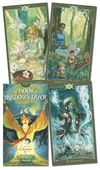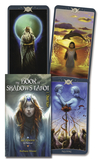The Book of Shadows Tarot, Volume 1: As Above
In 2008 I spent some time in Italy with the good folks at Lo Scarabeo. They asked me to create a deck, or rather a pair of decks. The set was to be called The Book of Shadows Tarot and was to be comprised of two separate decks. Beyond that, they had no requirements. I was free to do whatever I wished within that framework.
 It took a while before I figured out how to approach the project. One consideration was to create one deck as simply symbolic and the other simply evocative or intuitive. I still like that idea and might pursue it in the future. But I wanted the structure to somehow reflect the theme, a Book of Shadows.
It took a while before I figured out how to approach the project. One consideration was to create one deck as simply symbolic and the other simply evocative or intuitive. I still like that idea and might pursue it in the future. But I wanted the structure to somehow reflect the theme, a Book of Shadows.
Also, because I was trained in the Rider Waite Smith (RWS) tradition of tarot, those are the kinds of decks I've created. Maybe it was time to try something completely different. Tarot is continually evolving; it didn't begin as the RWS and likely won't end as that. So why not take this opportunity to create something completely new?
After considerable thought, I decided to use the spiritual belief, "As Above, So Below as my organizing theme.
The first deck would represent "As Above." In this deck, I would explore the non-RWS possibilities. Each card would represent the theory and teachings of Wicca.
The second deck, So Below, will be a RWS-based deck that shows how the magic of Wicca (for I believe that all of Wicca is Magic...although not necessarily the same as Witchcraft) is experienced by Wiccans in every day life.
Creating As Above was an exhilarating challenge. I worked within the structure of the Major Arcana and for suits with fourteen cards each. I kept the archetypal core meanings of the Majors fairly closely to RWS. The Minor Arcana, however, are not at all related to the RWS. For all of those who say all I make are RWS clones, well, here is my best effort at something completely uniquely mine.
As Above is a tarot deck designed to hold and express modern Pagan spiritual teachings. Pagan beliefs are broad and hardly unified, but more on that in a moment. The Major Arcana cards represent some of the basic tenets of Wicca and the Minor Arcana thoroughly explore elemental energies while providing foundations for further studies in the areas of astrology, the faces of the Goddess, the magic of the physical realm, and various forms of divination. Because each card is a portal into vast realms of knowledge and experience and because space in this book is limited, each section includes a reading list of excellent texts for further studies.
Here, I'll introduce you to some of the things I like best about the deck. The first is Key V. In traditional tarot, it is called The Hierophant, and in some Pagan decks, The High Priest. I call it The Book of Shadows, a book where write down their tradition, which is an ever-evolving experience, always growing, always changing, always dynamic.
Early on in the tarot's history, the Major Arcana cards were not numbered. However, we are now quite accustomed to putting numbers on these cards. This provides a number of benefits. For example, many readers like to incorporate numerology into their readings. Others consider the numerical sequence as a variation on the Hero's Journey (a concept popularized by Joseph Campbell and, in tarot circles, is called the Fool's Journey, a phrase first used by Eden Gray). As for me, I think one of the most practical aspects is so that beginners can easily find the card they are looking up as they first learn tarot. Mundane, perhaps, but from a beginner's standpoint, it is very much appreciated.
Following this useful tradition, the Major Arcana cards in this deck are indeed numbered. However, the Major Arcana cards are in groups that do not relate to the numbers printed on them. Instead, they are divided into different classifications that illustrate various aspects of Pagan beliefs.
The Major Arcana cards in this deck follow the archetypal ideas expressed in traditional tarot decks but express them from a Pagan point of view. In this way, the deck becomes an educational tool that a beginner can use to form a foundation for further studies. It is also an excellent reading deck that will resonate with the Pagan soul.
The first five cards represent very basic core beliefs. These are the essential aspects upon which all else is built. These include The God, the Goddess, the World, the Elements, and the Summerlands.
The second section includes the Wheel of the Year and eight Sabbats that make up the Pagan calendar.
The third group consists of the tools and experiences of the practicing pagan, such as initiation, Book of Shadows, and spellcasting.
In fact, here are all the Majors in their groupings listed by their traditional names and their Book of Shadows Tarot names in parentheses:
1. A Pagan Framework
XXI, The World (The World)
III, The Empress & IV, The Emperor (The Goddess & the God)
I, The Magician (The Elements) O, The Fool (The Summerlands)
2. The Circle of Life
X, The Wheel (The Wheel of the Year)
XVIII, The Moon (Samhain)
XIII, Death (Yule)
XVII, The Star (Imbolc)
XIV, Temperance (Ostara)
VI, The Lovers (Beltane)
XIX, The Sun (Litha)
XV, The Devil (Lammas)
XI, Justice (Mabon)
3. The Pagan Experience
IX, The Hermit (The Path)
VIII, Strength (Spellcasting)
V, Hierophant (Book of Shadows)
VII, Chariot (Transformation) VXI, The Tower (Warnings)
XII, The Hanged Man (The Circle)
XX, Judgement (Initiation)
II, High Priestess (Wisdom)
The Court Cards do not have traditional court cards. Instead, we have the Elemental, Maiden, Mother, and Crone.
The Elementals are pretty self-explanatory, and represent the Elementals of Air, Water, Earth, and Fire. The Maiden, Mother, and Crone cards represent the waxing, full, and waning aspects of each element. And so, you see, they are not like the Knight, Queen, and King.
Here are a few details of the Earth court by way of example:
The Maiden of Earth takes her place among the new blossoms of the field. She brings a sense of lightness and gratitude, a joyful appreciation and celebration of everyday blessings.
The Mother of Earth takes her place as Mother Nature, providing a rich harvest. She nourishes our bodies and our souls with the best of Her creation.
The Crone of Earth lays the Earth to rest. Even the Earth must regenerate, and there is a time for everything in this life, including death. The numbered Minor cards represent different elemental aspects of the Pagan universe.
The suit of Fire focuses on the wisdom and energy of the heavens and as such depicts astrological wisdom, with cards representing the Sun, Moon, Stars, and planets, with the focus on the masculine energy of gods for whom the planets are named.
The suit of Water balances the mostly masculine energy of the planets with various faces of the Goddess (for example Flora, Saravati, Ma’at, Cerridwen, and Hecate).
The suit of Air explores different methods of accessing Divine wisdom and guidance through various divinatory methods, such as Runes, Pendulums, I Ching, and of course Tarot. The suit of Earth reveals magical sources found on our planet.
The suit of Pentacles is my favorite in any tarot deck and this one is no different. If Wicca has any agreed upon sacred text it is the Earth herself. And so the suit of Earth reads her various "chapters" like liminal places such as the beach, where water and earth meet; plant life; animal life; mountains; etc.
The Book of Shadows Tarot is indeed unusual. For Pagans, it will be easy to adapt to, since you probably already have a firm understanding of the tenets used here as the images and concepts that shape the meanings. If you want to learn about the Pagan path, then it is a great deck for you, because it was designed to be a teaching tool, as well as a divinatory one. For tarot readers who aren't familiar with Pagan concepts but are interested, as lovers and interpreters of symbols, it should be an easy transition.
The deck is truly a book without bounds but pages you can shuffle to determine your path and create your own Book of Shadows that will help advise and comfort you through your life.

About Barbara Moore
Related Products


is subject to certain Terms and Conditions